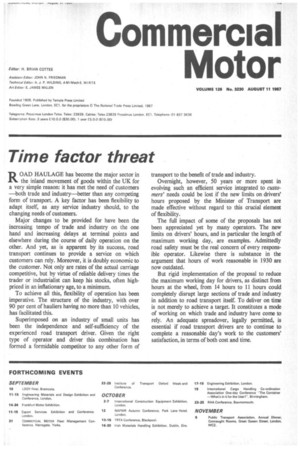Time factor threat
Page 17

If you've noticed an error in this article please click here to report it so we can fix it.
ROAD HAULAGE has become the major sector in the inland movement of goods within the UK for a very simple reason: it has met the need of customers —both trade and industry—better than any competing form of transport. A key factor has been flexibility to adapt itself, as any service industry should, to the changing needs of customers.
Major changes to be provided for have been the increasing tempo of trade and industry on the one hand and increasing delays at terminal points and elsewhere during the course of daily operation on the other. And yet, as is apparent by its success, road transport continues to provide a service on which customers can rely. Moreover, it is doubly economic to the customer. Not only are rates of the actual carriage competitive, but by virtue of reliable delivery times the trader or industrialist can keep his stocks, often highpriced in an inflationary age, to a minimum.
To achieve all this, flexibility of operation has been imperative. The structure of the industry, with over 90 per cent of hauliers having no more than 10 vehicles, has facilitated this.
Superimposed on an industry of small units has been the independence and self-sufficiency of the experienced road transport driver. Given the right type of operator and driver this combination has formed a formidable competitor to any other form of transport to the benefit of trade and industry.
Overnight, however, 50 years or more spent in evolving such an efficient service integrated to customers' needs could be lost if the new limits on drivers' hours proposed by the Minister of Transport are made effective without regard to this crucial element of flexibility.
The full impact of some of the proposals has not been appreciated yet by many operators, The new limits on drivers' hours, and in particular the length of maximum working day, are examples. Admittedly road safety must be the real concern of every responsible operator. Likewise there is substance in the argument that hours of work reasonable in 1930 are now outdated.
But rigid implementation of the proposal to reduce the maximum working day for drivers, as distinct from hours at the wheel, from 14 hours to 11 hours could completely disrupt large sections of trade and industry in addition to road transport itself. To deliver on time is not merely to achieve a target. It constitutes a mode of working on which trade and industry have come to rely. An adequate spreadover, legally permitted, is essential if road transport drivers are to continue to complete a reasonable day's work to the customers' satisfaction, in terms of both cost and time.












































































































